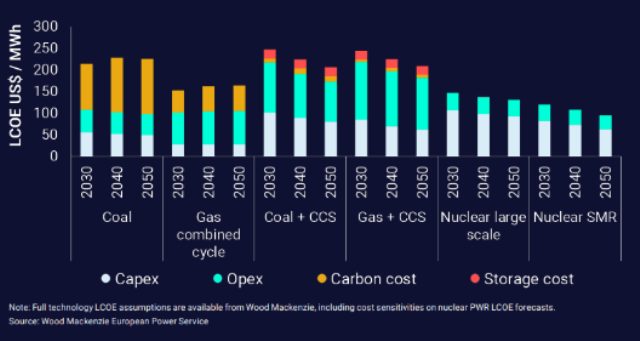The global nuclear capacity is projected to increase by 280 gigawatts (GW) by the year 2050 as countries seek decarbonized sources of electricity, according to a report by Wood Mackenzie.
However, despite policy support and market growth, the primary obstacle hindering the adoption of new nuclear and small modular reactors (SMRs) is their high cost.
Various technologies, including hydrogen-fired power, gas or coal with carbon capture and storage, geothermal, and long-duration energy storage, are competing to provide reliable decarbonized electricity. However, all of these technologies are costly and require technological advancements to establish a strong foothold in the market.
David Brown, Director of Energy Transition Service at Wood Mackenzie and lead author of the report, emphasizes the urgency for the nuclear industry to address the cost challenge if it wants to capitalize on the significant growth potential offered by low-carbon power. Currently, the cost gap between nuclear and other forms of low-carbon power generation is too substantial for nuclear to experience rapid growth.
The success of the SMR market expansion will rely on how quickly costs can be reduced to a level that competes with other forms of low-carbon power generation. Wood Mackenzie estimates that conventional nuclear power currently has an electricity cost that is at least four times higher than wind and solar power when considering the levelized cost of electricity (LCOE).
To overcome cost concerns, SMRs are designed to be modular, assembled in factories, and scalable. They are expected to reach the market faster, with a target construction time of three to five years compared to the ten years needed for a large-pressurized water reactor (PWR).
Wood Mackenzie’s modeling indicates that if costs can drop to $120 per megawatt-hour (MWh) by 2030, SMRs will be competitive with nuclear PWRs, gas, and coal (both abated and unabated) in certain regions around the world. Further price reductions are anticipated between 2040 and 2050 as SMRs benefit from economies of scale and improved market economics.
Up until 2030, SMRs are projected to have a limited presence in the power market due to high costs impeding their deployment. Moreover, the decade is already progressing, and the time required for construction means that only a few plants can be built at best.
According to industry estimates, the first-of-a-kind (FOAK) SMR costs could range from $6,000 to $8,000 per kilowatt (kW), with Wood Mackenzie analysts expecting FOAK costs to be on the higher end or even higher as developers undertake early-stage projects.
Wood Mackenzie’s tracking of SMR projects indicates that there are only six potential FOAK SMR projects in the pipeline between 2023 and 2030, with capacities ranging from 80MW to approximately 450MW. The amount of investment in FOAK SMRs remains uncertain and will be influenced by factors such as financing terms, commodity costs, uranium availability, and political support for project success.
According to Wood Mackenzie’s analysis and policy estimates, between 2030 and 2040, it is necessary to have 10 to 15 projects with a combined capacity of 3,000 to 4,500MW to support reduced SMR costs. This level of activity would help the nuclear industry regain the momentum it experienced during the previous growth phase from 1970 to 1990.

